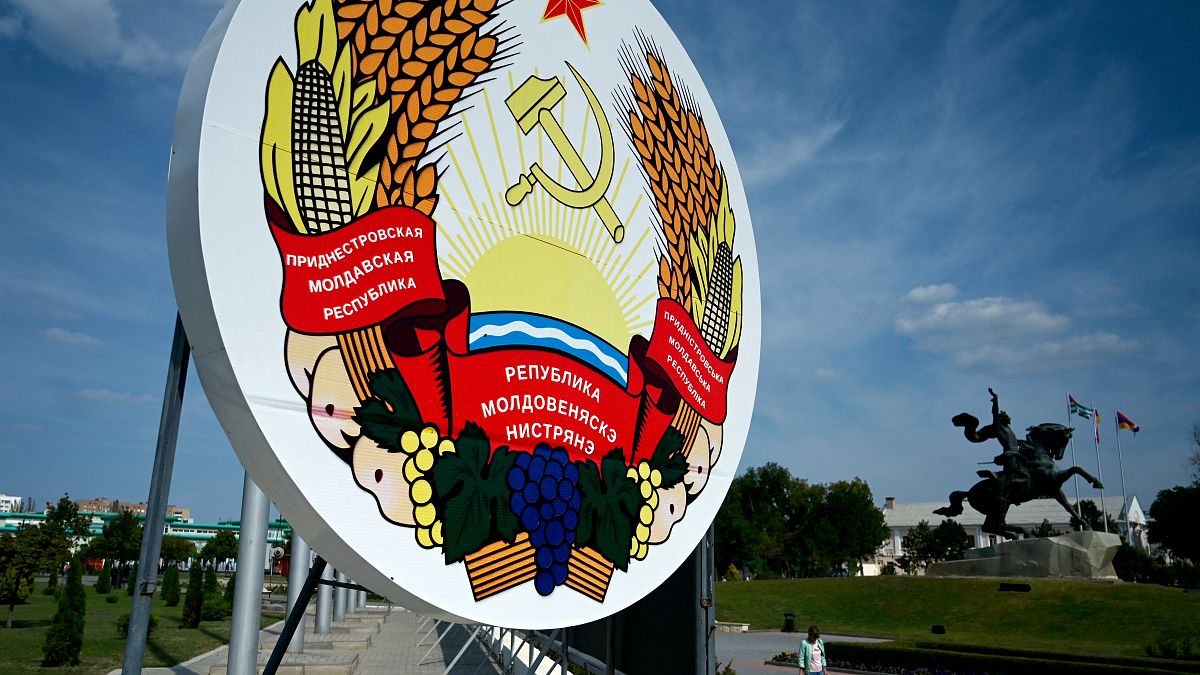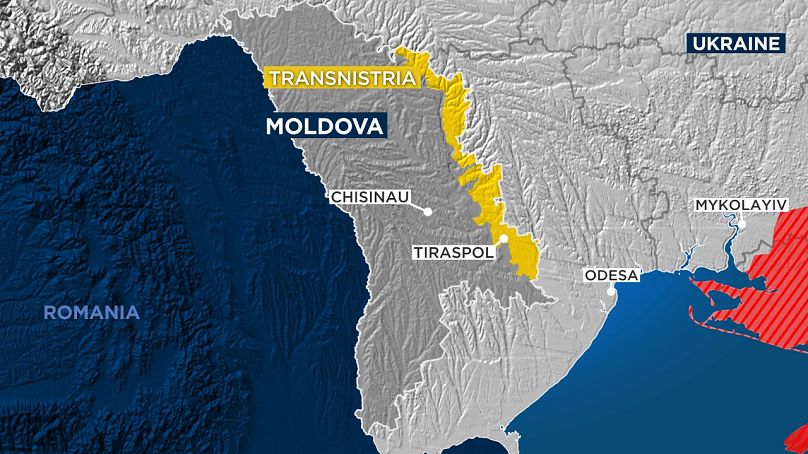Tensions have increased in the territory bordering Ukraine where Russia has a military presence, and which has long been engaged in a so-called "frozen conflict".
Tensions have increased in recent days in and around the Moldovan breakaway region of Transnistria, a place few in Europe have heard of but which could easily become a new flashpoint for the war in Ukraine.
Explosions that have occurred in the pro-Russia territory this week have raised concerns that the war across the border in Ukraine could soon be extended there.
Transnistria’s President Vadim Krasnoselsky called on Tuesday for a 15-day red alert, with anti-terrorist security measures put in place, like the setting up of roadblocks at the entrances to cities.
Moscow and Kyiv have blamed each other for the flare-up in tensions, accusing each other of wanting to drag Moldova and Transnistria into the conflict Russia sparked when it invaded Ukraine on 24 February.
“The traces of these attacks lead to Ukraine”, Russian news agency TASS quoted Krasnoselsky as saying.
This came less than a week after a senior Russian military official, Rustam Minnekayev, said that Russian forces were aiming to take full control of southern Ukraine and that such a move would open a land corridor between Russia and Transnistria.
Watch the video explainer on the background to the situation in Transnistria, in the player above.
Where the hammer-and-sickle still rules
A long and narrow strip of land on the eastern edge of Moldova, Transnistria has been considered a “frozen conflict,” following the breakup of the Soviet Union in 1990 and a brief civil war with Moldova in 1992.
That months-long conflict left an estimated 700 people dead. Since then, the region has operated as an independent state, though one not recognised by other countries or the United Nations.
Russia has maintained a military presence of about 1,500 soldiers in Transnistria since 1992, ostensibly as peacekeepers. It also has a tight political and economic grip on the territory, providing free gas and other support.
However, since Russia's annexation of Crimea and war begun in Ukraine's Donbas region, both in 2014, Transnistria's trade ties with Europe have significantly increased under a deal signed between Moldova and the EU the same year.
Transnistria extends for about 400 kilometres between the eastern bank of the Dniester River in Moldova and the country's border with Ukraine, and is home to a population of about 470,000 predominantly Russian speakers.
The 70-kilometre journey from the Moldovan capital, Chisinau, to Tiraspol, the capital of Transnistria, takes around 90 minutes, passing through an unofficial “border” checkpoint manned by Transnistrian soldiers. From Tiraspol to the Ukrainian city of Odesa is just over 100 kilometres.
Transnistria and its capital can feel like stepping into a time warp, with Soviet iconography like the hammer-and-sickle prominently displayed on flags and buildings, and a statue of Vladimir Lenin standing outside the parliament building.
While Moldova, one of Europe’s poorest nations, has increasingly moved towards the European Union in recent years, Transnistria has kept its strong ties to Russia.
In March, Moldova signed an official request to join the EU, though that process would likely take many years and the country is currently far from able to comply with the bloc's conditions for membership.
The same month, Prime Minister Natalia Gavrilița told Euronews that her government was "not discussing" any option to join NATO, and that the country wanted to maintain its neutrality.
As with Ukraine, Russia has long sought to keep Moldova in its political sphere of influence. Both countries were formerly part of the Soviet Union. Some have accused Russia of using Transnistria as a means of exerting pressure on Moldova.
In the crossfire
On Monday, explosions rocked the headquarters of the region's state security ministry, potentially rocket-propelled grenades, with no casualties reported. On Tuesday morning a pair of explosions knocked out two powerful broadcasting antennas used to transmit Russian broadcasts. No one has claimed responsibility for any of the attacks.
A day later, authorities in Transnistria said that a village bordering Ukraine, hosting a large Russian army ammunition depot, had been the target of weapons fire.
“From the information we have at this moment, these escalation attempts stem from factions within the Transnistrian region that are pro-war forces and interested in destabilising the situation in the region," Moldovan President Maia Sandu told a news conference on Wednesday.
Following Tuesday's reports of explosions, social media users posted that some residents in the breakaway region had received text message warnings claiming to be on behalf of Ukrainian agencies stating that the country’s military was planning an attack.
No such strike was reported in Transnistria, and two Ukrainian government sources said the text messages were not sent by Ukrainian authorities.
“The state of Ukraine has nothing to do with this and similar provocations,” the military's main intelligence directorate wrote in a statement in Ukrainian.
The US has previously warned that Russia could launch false-flag attacks in nearby nations as a pretext for sending in troops.
However, on Tuesday Russian Deputy Foreign Minister Andrey Rudenko said that Moscow was "concerned" about the string of explosions, adding that Russia “would like to avoid a scenario” in which Transnistria would be dragged into the war.
Concerns have certainly been expressed that Russia may look to use Transnistria to launch an attack on Moldova — which has only a small military force. But Vladimir Putin's forces would first need to make far more significant progress in southern Ukraine than they have up to now.

